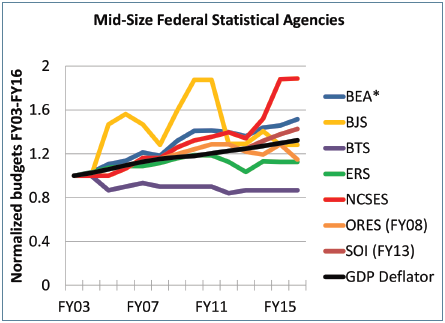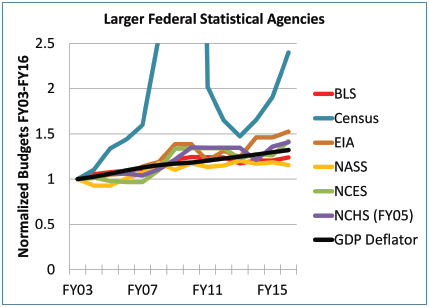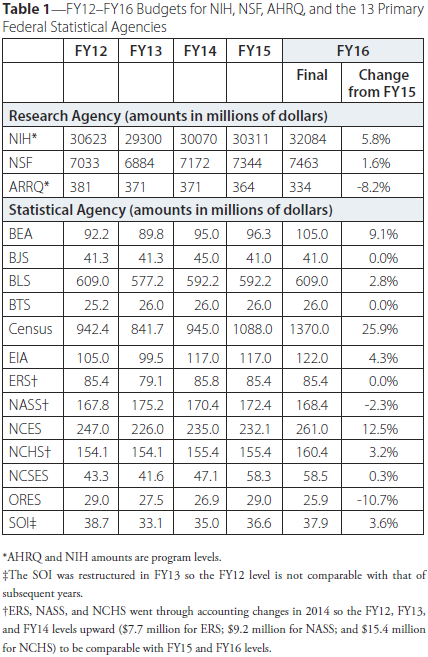Final FY16 Spending Bill Provides Increases for NIH, Census, Statistical Agencies
Saves Agency for Healthcare Research and Quality
Steve Pierson earned his PhD in physics from the University of Minnesota. He spent eight years in the physics department of Worcester Polytechnic Institute before becoming head of government relations at the American Physical Society.
The Fiscal Year 2016 (FY16) omnibus spending bill, which provided the budgets for the entire federal government and was signed into law in mid-December, included needed increases for the National Institutes of Health (NIH) and many federal statistical agencies. The bill also was welcomed for what it didn’t include: House provisions making the American Community Survey (ACS) voluntary and cutting the budgets for the National Science Foundation (NSF) Social, Behavioral, and Economic Sciences (SBE) Directorate and Geosciences (GEO) Directorate. The generally better funding was made possible by this fall’s budget deal increasing the overall caps on the FY16 and FY17 budgets.
NIH, NSF, and AHRQ
With bipartisan recognition of the need to increase its budget, NIH saw a 5.8% boost to $32.1 billion, the largest increase since its doubling concluded in FY03. $200 million of the increase is for the president’s new Precision Medicine Initiative. The budget also increases funding for the president’s Brain Research through Advancing Innovative Neurotechnologies (BRAIN) Initiative by $85 million (to a total of $150 million) and Alzheimer’s disease research by $350 million (to $936 million.)
The agreement also stresses the importance of reproducibility of scientific methods, stating Congress “expects NIH to continue to stress the importance of experimental rigor and transparency of reporting of research finding to enhance the ability of others to replicate them.”
For Big Data to Knowledge (BD2K), the administration requested an increase of $19.5 million to $63 million, but the agreement does not specify a final BD2K level.
The NSF saw a 1.6% increase for its budget to nearly $7.5 billion. The agreement includes $147 million for neuroscience and cognitive science research done through NSF’s Understanding the Brain activity, which includes the BRAIN Initiative. The agreement also stipulates a minimum of $160 million for cybersecurity research. Perhaps more significantly, as noted above, the agreement did not adopt the House cuts to the SBE and GEO directorates, though it freezes the SBE budget at its FY15 level.
In an interview with Science magazine shortly after Congress approved the spending bill, longtime NSF champion Rep. John Culberson (R-TX), chair of the House Commerce, Justice, Science (CJS) appropriations subcommittee—which, with its Senate counterpart, helps to set the budget for NSF—says he remains “committed to do[ing] the very best possible to ensure that NSF is fully funded.” Regarding the House cuts to GEO and SBE, he noted strong opposition to the cuts by other parts of Congress and the need to compromise. He also added he didn’t disagree with the social and behavioral community that “their research and expertise is essential to solving some of the toughest problems facing society.”
The Agency for Healthcare Research and Quality (AHRQ) budget was cut 8.2%, but that is relatively good news after the House zeroed the FY16 AHRQ budget and the Senate cut it by 35%. (The House also zeroed the AHRQ FY13 budget in 2012.) The chambers were concerned that AHRQ funding was redundant to that of NIH and other agencies. The community, including the ASA and Health Policy Statistics Section, was active in the advocacy for restoring the AHRQ budget. The following language was included for AHRQ: “The agreement expects AHRQ to focus its research on its traditional mission, such as improving patient safety and preventing health care-associated infections.” The AHRQ budget is now 12% below its FY12 level.
Federal Statistical Agencies
Though the U.S. Census Bureau requested a budget of $1.50 billion for FY16 as part of the multi-year ramp up for the 2020 decennial census, the final level of $1.37 billion was welcomed after the House cut its budget below the FY15 level this summer and the Senate provided an increase of only $40 million.
As noted above, the final bill omitted the House provision to make the ACS voluntary. While the mandatory ACS has seen continual threats over the last several years, the Census stakeholder community was especially concerned this year with the Senate having changed to a Republican majority and a new chair of the CJS appropriations subcommittee—which helps determine the Census budget—who had long expressed strong feelings that the ACS not be mandatory.
The Senate remained strongly supportive of the mandatory ACS, and Culberson took a more measured approach to address his ACS concerns. In the Science interview, Culberson said he will be monitoring the ACS work very closely. “I do not want to see them harassing American citizens or invading their privacy. I continue to believe that the ACS should not compel people to reveal details about their personal lives. An American’s most fundamental right is the right to be left alone and not have the government invade their privacy,” he said. “I made sure that the Department of Commerce has enough money to perform its constitutional duty to do a 2020 Census. But we want to make sure that the money is spent wisely and that they don’t have another [computer] disaster like they did for 2010.”
The 9.1% increase for the Bureau of Economic Analysis (BEA) includes $5 million for the move from downtown Washington, DC, to the headquarters of the U.S. Census Bureau in Suitland, Maryland, leaving an additional $4 million (or a total of approximately $100 million) for program activities. The programmatic level of $100 million restores BEA to its FY12 level of $92.2 million, accounting for inflation (though still short of the FY10 level of $93 million.)
The third economic statistical agency, the Bureau of Labor Statistics (BLS), received a boost of 2.8% to $609 million. The level is disappointing in comparison to its FY12 level of $609 million, but welcome compared to its FY13–FY15 levels and considering the Senate proposed to cut the BLS budget by 2%. In retrospect, the Senate’s proposal to cut BLS by 2% was helpful in that it resulted in numerous articles and column in support of BLS’s work and urging a stronger budget.
The other agencies that received an increase in the omnibus bill are the Energy Information Administration (EIA) (4.3%), National Center for Education Statistics (NCES) (12.5%), and National Center for Health Statistics (NCHS) (3.2%). Congress did not provide $12 million in mandatory Prevention and Public Health Fund for NCHS requested by the administration and included in past years. The Bureau of Justice Statistics (BJS) and Economic Research Service (ERS) were both held at their FY15 levels, and the National Agricultural Statistics Service (NASS) was cut 2.3%.
Based on initial estimates, the National Center for Science and Engineering Statistics’ (NCSES) budget is flat from FY15; the Internal Revenue Service Statistics of Income Division’s (SOI) budget increased 3.6%; and the Social Security Administration Office of Research, Evaluation, and Statistics’ (ORES) budget was reduced 10.7% (following completion of its funding for the latest Survey of Income and Program Participation Panel.)
The budget for the Bureau of Transportation Statistics (BTS) was determined through the surface transportation bill—the Fixing America’s Surface Transportation (FAST) Act, H.R. 22—also made law in December. The BTS budget is determined outside the annual appropriations bill because it is funded through the cash-strapped Highway Trust Fund. The FAST Act holds the BTS budget at $26 million through FY20, the same level it had in FY05, which will amount to a 30% cut from FY05 to FY20 due to inflation.
The BTS budget, the smallest of the 13 agencies reported here, has been further diminished by funds—an unknown amount but believed to be much higher than typical overhead rates—diverted by the Research and Innovative Technology Administration and its successor in the Office of the Secretary for Operations. The FAST Act did include provisions advocated by the ASA to increase BTS autonomy, especially for publications and IT.
Figures 1 and 2 put the FY16 budgets in a longer-term perspective, showing their budgets normalized back to their FY03 levels. For the mid-size agencies (Figure 1), one sees BEA and NCSES receiving increases above that of inflation (though the BEA budget was relatively flat from FY10–FY15.) BTS and ERS have both lost purchasing power due to inflation, while BJS and ORES have mostly kept up with inflation since FY03. The BJS budget has seen large increases and subsequent decreases, however.

Figure 1. The budgets of the seven mid-sized statistical agencies normalized to their FY03 levels, along with the GDP deflator to account for inflation. The Social Security Administration Office of Research, Evaluation, and Statistics’ budget is normalized (and adjusted for inflation) to its FY08 level, when the current accounting scheme was implemented. Similarly, the Statistics of Income budget is normalized to its FY13 level.
For the larger statistical agencies (Figure 2), the U.S. Census Bureau and EIA have done better than inflation since FY03, though a sizable part of the apparent Census Bureau budget increase is due to the conversion in the mid-2000s of the decennial long-form census to the now monthly American Community Survey. With recent increases, NCES an NCHS are just above the inflation since FY03, while BLS and NASS are below.

Figure 2. The budgets of the six larger statistical agencies normalized to their FY03 level, along with the GDP deflator to account for inflation. The NCHS annual budgets are normalized (and adjusted for inflation) to the FY05 level, when the current accounting scheme was implemented. The U.S. Census Bureau line peaks at 12.65 in FY10.


















